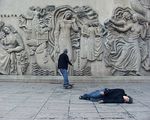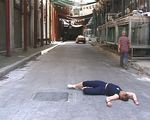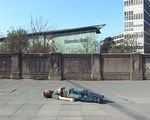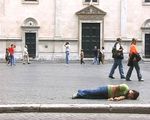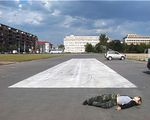WEST(Paris)(Roma)(Amsterdam)(Athina)(Wien)(Berlin) (Bruxelles)(London) (Beijing)(Praha)(Tokyo)(New York) - Kinkaleri
←
→
Trascrizione del contenuto della pagina
Se il tuo browser non visualizza correttamente la pagina, ti preghiamo di leggere il contenuto della pagina quaggiù
WEST(Paris)(Roma)(Amsterdam)(Athina)(Wien)(Berlin)(Bruxelles)(London) (Beijing)(Praha)(Tokyo)(New York) project, realization Kinkaleri / Matteo Bambi, Luca Camilletti, Massimo Conti, Marco Mazzoni, Gina Monaco, Cristina Rizzo production Kinkaleri – 2002-2008 | in collaboration with Xing | (Paris) co-production Batofar, Xing - 2002 | (Roma) co-pro- duction Festival Enzimi – 2003 | (Amsterdam) co-production Centro per l’Arte contemporanea Luigi Pecci - 2003 | (Athina) co-production Video Dance - Thessaloniki International Film Festival - 2004 | (Wien) co-production Tanzquartier Wien - 2004 | (Berlin) co-production HAU Hebbel am Ufer, Ente Teatrale Italiano - 2005 | (Bruxelles) co-produzione Kaaitheater – 2005 | (London) co-production RED Festival - 2006 | (Beijing) co-production Istituto Italiano di Cultura di Pechino - 2006 | (Praha) co-produzione Festival 4+4 Days in Motion 07 - 2007 | (Tokyo) co-production Danza Urbana, 4th Skin Arts Project, Istituto Italiano di Cultura di Tokyo – 2007 | (New York) cco-production OAC Osservatorio per le Arti Contemporanee – Ente Cassa di Risparmio di Firenze - 2008 WEST is a project to develop in the cities of the West used as a contact surface for a set of deaths following one another while everything streams on the tracks of a planet that includes them. The evidence of the limit of each We- stern process, a course that does not produce a thing, a mechanism waiting for the end, arising every day and every day pursued more and more quickly, anxiously, painlessly. Gained is the apex, waiting now for the next explosion. Done for is the world and it comes apart at the seams. It repeats its tightly-knit death pointlessly and effortlessly. No debut, no fulfilment, no satisfaction. Travels are expected to the different cities where what takes place is the immortalization of the represented construction of acts of dying through the support of a video-camera followed by the editing of tho- se images, those deaths. The city does not die, everything gets concrete in its ordinary course. Each subject is on the same level; the watcher is being watched and the city turns into the identification of the representation of the contem- porary Western city. Everything is ordinary and manifest, and swapping places is not altering a thing; being seen does not allow death but the death maintains the vision through the connection of the eyes of the watcher and the one being watched both watching the one who watches and then collapses, with an act that since childhood has not been performed without the possible protection of the representation. The city stays where it is: it declares itself unique and multiple, for itself and for many other cities, and by releasing the differences the West strains to recognize itself everywhere in a tidiness; and yet everything slides and gets clogged onto those bodies, and all that the frame includes risks falling therein. To skim the border continuously , to caress it like a precious thing, no illusion, no pain. To ask a stranger to do something for me, something I could do without, that the stranger could do without, to sub- stantivize the unlikely need of a hoarse complicity, to stop him in the street interrupting one way of his, one itinerary of his, one occupation of his, to ask him to stare at the lens for about fifteen seconds from his distance, he is being part of a framing, to ask him to keep his gaze staring and after the agreed approximation of time to fall to the ground, acting in full awareness of it, to leave a void, to operate autonomously, a body on the ground, without a specific behaviour, without interpretation, without melodrama, the last possible fall, to die falling to the ground, to be remaining to die at the past participle tense on the ground for at least ten seconds and anyway not before he is been told that everything is over, we got an agreement, while all around the rest goes on by itself, following its own organization. WEST is a video project comprised of 12 separate episodes where the cities of Amsterdam, Athens, Beijing, Berlin, Brussels, London, New York City, Paris, Prague, Rome, Tokyo and Vienna are the background where - over and over - anonymous passers-by are asked to fall “as falls a body that is dead”, while the city life keeps moving along. Started in 2001 in Paris as the “study #7” in preparation of the performance , WEST has become a standalo-ne project with the addition of more capital cities of the Western world, meaning a cultural and not a geographical world. The various spots of the cities - identifiable sometimes, featureless and vague in other cases - are presented with bodies that fall; a person stands still and stares at the lens of the video camera for a fixed number of seconds before deciding to fall to the ground. This same action - repeated by a multitude and deprived of any representative intent - amplifies the circularity of time and expands it endlessly. The structure of WEST is as precise as a mathematical formula: static shot, position timing and camera looking, then the fall. Intentionally filmed like on a set where the action of falling gets revealed by the presence of the video camera and the staff shooting, the work develops within the relationship of three elements: landscape, “dead body”, extras. That is how WEST - as well as portraying the “West” that receives it - activates a more extensive reflection on perception. The body - changing from vertical to horizontal, to its final stillness - becomes the unit of measurement for a highlighted landscape - unaltered and distant after all - that remains true to itself though opening up to a series of questions about what can still be seen. WEST is available for different installation arrangements depending on location and facilities: a single continuous showing as a triptych, or twelve separate videos screened or through monitors. video https://vimeo.com/234213054
WEST(Paris) production Kinkaleri, Batofar, Xing - 2002 lenght 20’45” WEST(Roma) production Kinkaleri, Festival Enzimi - 2003 | in collaboration Xing lenght 24’24” WEST(Amsterdam) production Kinkaleri, Centro per l’Arte contemporanea Luigi Pecci - 2003 | in collabortion Xing lenght 24’23” WEST(Athina) production Kinkaleri, Video Dance – Thessaloniki Internationl Film Festival - 2004 | in collaboration Xing lenght 25’01” WEST(Wien) production Kinkaleri, Tanzquartier Wien - 2004 | in collaboration Xing lenght 24’44” WEST(Berlin) production Kinkaleri, HAU Hebbel am Ufer, Ente Teatrale Italiano - 2005 | in collaboration Xing lenght 28’30”
WEST(Bruxelles) production Kinkaleri, Kaaitheater | in collaboration Xing, Comune di Firenze lenght 29’30” WEST(London) production Kinkaleri, RED Festival - 2006 | in collaboration Xing lenght 29’15” WEST(Beijing) production Kinkaleri - 2005 | in collaboration Istituto Italiano di Cultura di Pechi- no, Xing lenght 24’25” WEST(Praha) production Kinkaleri - 2007 | in collaboration Ente Teatrale Italiano, Festival 4+4 Days in Motion 07, Xing lenght 30’41” WEST(Tokyo) production Kinkaleri - 2007 | in collaboration Associazione Danza Urbana, 4th skin Arts Project, Istituto Italiano di Cultura di Tokyo, Xing lenght 25’31” WEST(New York) production Kinkaleri, OAC Osservatorio per le Arti Contemporanee – Fondazione CR Firenze - 2008 | in collaboration Istituto Italiano di Cultura di New York, Xing lenght 27’23”
press review West, corpi che si accasciano di Andrea Lissoni su Rolling Stones Italia - marzo 2004 Non danza nessuno. Anzi, le persone crollano a terra. E attualmente la migliore compagnia di danza di ricerca in Italia, anche se di fatto, è una bizzarra band, senza solisti: sono i Kinkaleri, e quelle che cadono a terra nelle capitali d’Europa (nella performance West, al Centro per l’Arte Contemporanea Luigi Pecci di Prato, dal 6 marzo al 18 aprile) sono persone qualsiasi, passanti. Corpi folgorati senza motivo da non si sa che cosa, clinicamente scrutati da una telecamera frontale. È questo l’Occidente oggi. Chiunque, a caso, non si sa perché, crolla improvvisamente. West nasce come un’estensione dallo spettacolo Otto, un piccolo capolavoro della danza — chiamiamola così anche se non solo di quello sì tratta — di inizio millennio. È una testimonianza, uno sguardo sull’Europa. Suona tragico, apocalittico, un filo malinconico, senz’altro politico. Suona impetuoso semplice, leggermente distorto, come da un vocoder. Happy songs for happy people. Suona un pò così, energicamente fallimentare, e splendente, come l’ultimo Mogwai. L’occidente e il congedo dalla vita di Anna Abate su I Viaggi di Repubblica - 1 aprile 2004 “West” è un lavoro in evoluzione in parte già realizzato in tre città europee (l’Occidente che dà il titolo al progetto), usate come luoghi simbolici che fanno da cornice a rappresentazioni dell’atto del morire. La compagnia di teatro- danza Kinkaleri si è spostata nelle città prescelte (Parigi, Roma e Amsterdam) filmando le "morti" con la telecamera. Le immagini di ciascuna città, montate e proiettate ognuna su un singolo schermo, costituiscono l’installazione appositamente pensata per la Project Room del Centro d’arte contemporanea Luigi Pecci di Prato. Il progetto “West” è stato realizzato sulla base di un’idea semplice e, allo stesso tempo, originale. Gli artisti di Kinkaleri, andando in giro per le metropoli europee, hanno fermato uno sconosciuto, interrompendo un suo percorso, un suo itinerario, una sua occupazione, e gli hanno chiesto di guardare fisso nell’obiettivo della telecamera per quindici secondi; allo scadere del tempo stabilito, l’improvvisato attore/attrice doveva cadere a terra, con la propria consapevolezza di farlo, con l’intenzione di lasciare un vuoto, un corpo sul selciato: senza un particolare comportamento, senza interpretazione, senza melodramma, mentre tutto il resto intorno continua a esistere. WEST di Pietro Gaglianò su Exibart - aprile 2004 […] Le morti di West, neutre, ripetibili, dichiaratamente insincere e messe in scena grazie a un casting casuale e del tutto democratico, annotano come estrema possibilità l’autonomia di scegliere dove portare lo sguardo. La morte- caduta è un pretesto ma è leggibile anche come un simbolo dell’inevitabile compimento dell’operazione artistica: la messa a punto di un sistema che programma la propria sterilizzazione non appena incontra i confini del territorio della ricerca. I Kinkaleri continuano ad esplorare e si concedono, oltre questi confini, un’altra possibilità. WEST di Saretto Cincinelli su Flash Art - luglio 2004 Da qualche tempo sulla scena nazionale e internazionale, ricerche di teatro e danza tendono a confondere il proprio percorso con quello delle “arti visive”. Non si tratta di una novità né, soprattutto, di un movimento a senso unico: parallelamente, infatti, esperienze artistiche orientate al rinnovamento della performance o della scultura muovono in direzione opposta. In questo territorio di frontiera segnato, non dal miraggio di una fusione delle arti, ma dalla volontà delle singole discipline di scartarsi dal proprio specifico, opera Kinkaleri (Premio Ubu 2002). Il gruppo propo- ne, in questa occasione, una videoinstallazione per tre schermi che mostra un susseguirsi frontale di cadute che sono avvenute o che potranno avvenire in diverse metropoli occidentali, a opera di comuni passanti. Uno schermo unico posto fuori dalla project room del museo Pecci di Prato trasmette invece il segnale di una videocamera che inquadra un set predisposto all’esterno del museo, in cui i visitatori possono cimentarsi in un mancamento in diretta. Mentre l’orizzontalità della proiezione multipla, sorta di collage spazio-temporale, arricchisce l'opera con la contiguità di diversi sfondi, creando minime ma significative variazioni ritmiche con l’asincronismo delle varie cadute (a volte im- merse in un silenzio irreale altre nel rumore metropolitano), o con differenti reazioni dei passanti di fronte a un corpo inerte, quella realizzata in diretta accentua, invece, il gesto della caduta colto nella sua singolarità e nell’astrazione di un unico sfondo. Lo spettacolo del ritrarsi che caratterizzava , una precedente straordinaria piéce del gruppo, imperniata sulle cadute degli attori, finisce qui per trasformarsi in un ritrarsi dello spettacolo che ci invita a ripensare l’immagine come un evento in cui la rappresentazione cede, per così dire, il passo alla presentazione.
Puoi anche leggere




